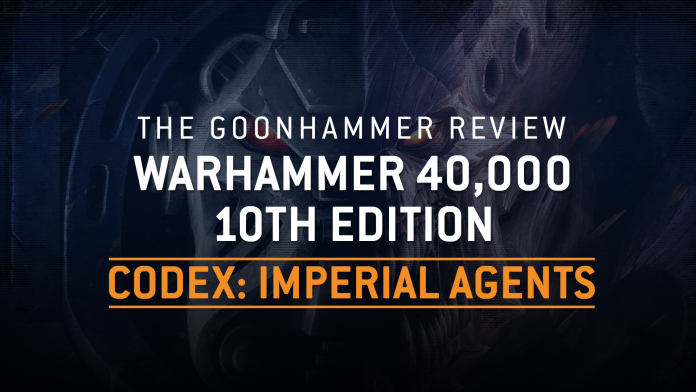One of the reasons people love the 40K universe so much is the sheer depth of weird stuff you can dig into. There’s more than 30 years of established lore to play with, and in the last few years Games Workshop has started using Kill Team as a route to put out new plastic versions of old-school fan favorites like the Arbites and Rogue Traders, while also using boxed games and campaign books to push out individual Character models from the stranger parts of the Imperial portfolio. These have all been badged under the heading of Imperial Agents, and there has been gradual movement towards really determined players being able to field them as an independent army, but even with the Index cards for 10th Edition it was pretty hard work.
Arriving this weekend, Codex Imperial Weirdos Agents finally brings all this together as a genuinely supported army, using the 10th Edition Faction/Detachment model to combine all these elements with a refined selection of Inquisitorial auxiliaries like Deathwatch and Grey Knights in the style of the legendary Daemon and Witch Hunters books from 3rd Edition. It also enhances the selection of supporting tools that other Imperium armies can throw into the mix, and soups up the infamous agents of the Officio Assassinorum to new heights.
The results are definitely interesting if a bit uneven, but the important headline is that there’s one detachment here that feels genuinely real on a competitive level, and it’s the one that lets you use the broadest selection of stuff, so if you’re the one guy who has been maining Imperial Agents in 10th, you are about to be on the ground floor of unleashing something new and exciting.
Wings: To be clear this is not a hypothetical one guy. I played against him. He was very nice.
Let’s dig in and find out what happens when you get weird with it. Wings and TheChirurgeon are here to explore what this book can do. As usual, before we begin we’d like to thank Games Workshop for providing us with a review copy of the Codex.
Army Overview

As alluded to in the introduction, there are two key additions to the Imperial Agents book compared to the Index that really make them work.
First up, obviously, are detachments – you get one of these for each of the main Inquisitorial orders, which tend to be heavily themed and far too niche for serious competitive play, then one for the Imperial Fleet, which works with everything and is genuinely good.
Second is the addition of variants of datasheets imported from other books, rebadged with the Imperial Agents Faction Keyword and with a few tweaks to their rules so that they work outside the context of their normal armies. This means that you can add some Deathwatch, Grey Knight Terminators or Battle Sisters to your lists, or indeed add these as Assigned Agents in other armies. This helps fill out the roster for Imperial Agents, and in particular the ability to combine Deathwatch with some of the Imperial Fleet detachment rules is what helps give the army legs. This is a really fun use of the way Factions work in 10th Edition – it lets you do something like this, where you can just declare that if you want to play this army, you’re drawing on this specific suite of additional datasheets, rather than either going super broad or super narrow as you’d end up doing in 8th and 9th.
Having had time to digest it, we think the following are four standout features of this book:
- The vibes. They are immaculate. The 3rd Edition Daemonhunters and Witch Hunters books had an energy people have been pining after for literal decades. Here you go!
- The Imperial Fleet. Great detachment, more on that later.
- Assassins. GW have gone for making these more terrifying at a higher cost, which is a much cooler representation of their lore.
- Potential. The execution here is uneven, but there’s a lot of promise in what GW have tried here, and we’ll hopefully see some (better implemented) version of similar ideas elsewhere. Gimme an Ynnari book like this GW. Aeldari players can be trusted with that power.
As is usually the case, there are also a few things we don’t like:
- No Army Rule. There’s still no army-level bonus for going pure Agents. They do get one cool bonus that’s clearly intended to compensate for this, but it’s not enough, and even something like “one free Core Stratagem on an Agents unit per battle round” would have been nice, particularly because of how narrow some of the detachments are.
- The Deathwatch get shafted. The Alien Hunters detachment is the narrowest of the bunch, and if there’s a way to build a good army with it, we haven’t figured it out yet. It’s also just a downgrade from the Index for them.
- All the detachments that aren’t the Imperial Fleet. The Ordo Hereticus and Malleus detachments both have great vibes, but are far too narrow to be interesting. All three Ordo detachments definitely needed something more.
- No Eisenhorn. Come on GW, we know most Finecast stuff is leaving, but Trazyn got to stay, and presuming that was on the basis of being a face character for one of the most popular recent novels, it’s wild not to keep rules for Eisenhorn.
Where’s Crusade?
There are some pretty cool Crusade rules in this book around having an Inquisitor hanging around your army. As usual, we’ll cover those on the Tuesday following this review’s publication – so check back then!
Army Rule: Assigned Agents
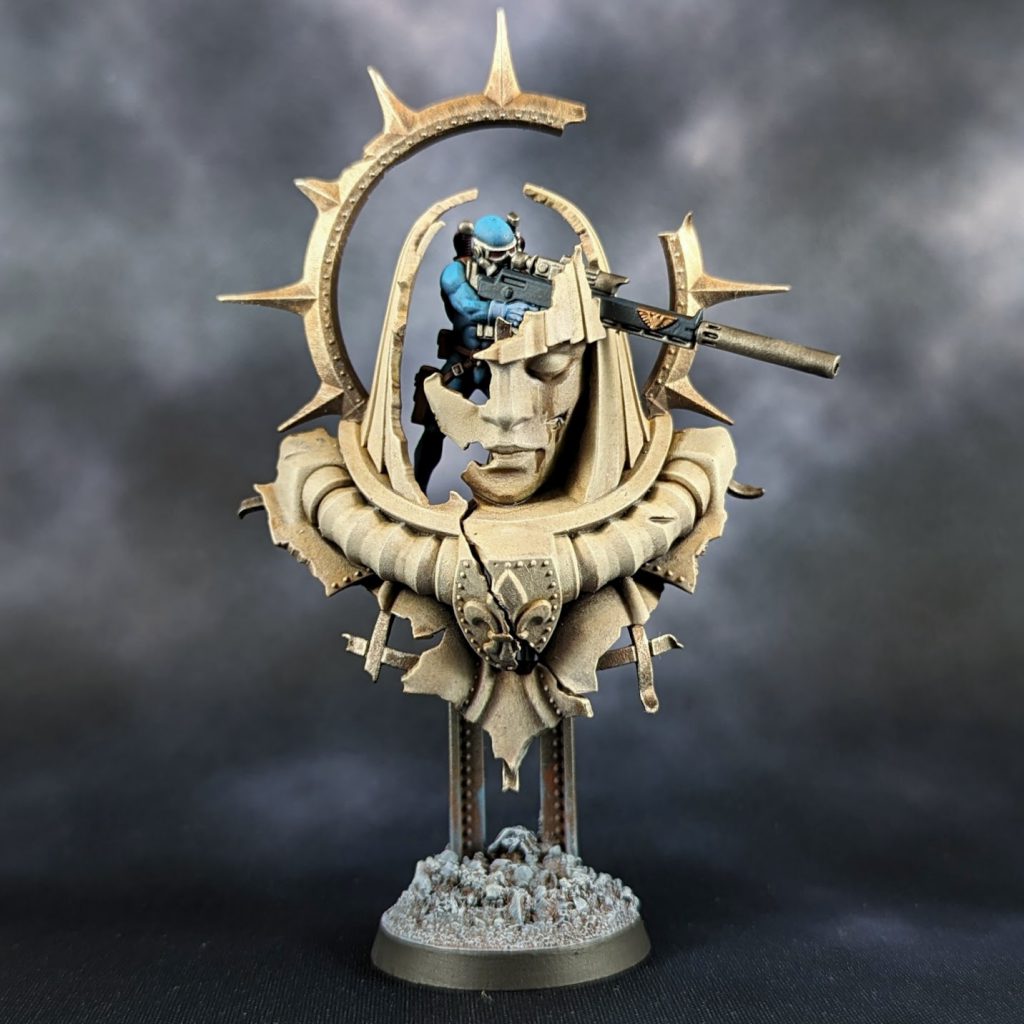
If your army faction is AGENTS OF THE IMPERIUM, then you can use one of the Agents Detachments. Otherwise, if your army faction is something else but every model in the army has the IMPERIUM keyword, then when building your army you can include a certain number of AGENTS OF THE IMPERIUM units. How many depends on the unit type and the battle size. In a 2,000-point game, you can include up to two RETINUE units, two CHARACTER units, and one REQUISITIONED unit.
Characters are pretty obvious but the other two are a bit less scrutable. Basically, anything in the book that isn’t a CHARACTER is a RETINUE unit with the exception of the Grey Knights and Sisters of Battle. Essentially, it provides a way for some units to be badged as “rarer” than the others for tagging into other lists. Note that the faction’s Dedicated Transports – the Immolator, Chimera, and Rhino – do not have any of these keywords but can still be included in IMPERIUM armies, though if they don’t start the game with a unit inside they’re removed as casualties like other Dedicated Transports.
Generally, this is the rule that’s going to break the game wide open. As we wrote this review there was distinctly mixed enthusiasm among our staff for some of the book’s Detachments – all their vibes are pretty great, but with one exception they’re all absurdly weak and/or narrow. On the other hand, some of the things you can do with this book for other armies is insane – Battle Sisters and Grey Knight Terminators in particular just let some armies do things they couldn’t before, and the new profiles for the Vindicare and Eversor Assassins are downright rude. It’s difficult to imagine a future where this book’s most powerful units aren’t showing up in every serious Imperium list.
Detachments
You can find our thoughts on the detachments in the articles below:
(Note that these will go live shortly after the main review, so if you’re up bright and early in the UK, wait half an hour).
Datasheets

Codex: Imperial Agents gives us updated datasheets for a generic Inquisitor, three named Inquisitors – one from each Ordo – and all of the hangers-on we’ve seen come out of Kill Team and Blackstone Fortress over the last five years, including Rogue Traders, Navy Breachers, Inquisitorial Agents, and Adeptus Arbites. In addition to those, the book includes four Deathwatch units (RIP to that faction), Grey Knight Terminators, Sisters of Battle Squads, and a trio of Transport options.
As an important note, yes we saw Warhammer Community’s announcement about there being separate points costs for taking units in pure Imperial Agents armies and as allies. We’re all for it, but that’s not here in the book, so we have no idea what the differences are going to be. We’ve based our evaluations on a mix of the current book costs and a few judgment calls about how those might change given the current MFM costs.
What’s Not Here
A number of classic units do not appear to have made the jump to this book, and as such we suspect they’re headed for legends. This includes Inquisitor Karamazov, Eisenhorn, and some specific hangers-on like Daemonhosts and Jokaero. Some Imperial weirdos are just too weird, even for modern 40K, it seems.
New Datasheets
Thanks to various things getting shuffled around, rebadged and imported, there are a few new datasheets in this book. We’re going to treat Inquisitorial Agents as an update to Inquisitorial Henchmen, but one model gets the tap on the shoulder to become a unit in their own right:
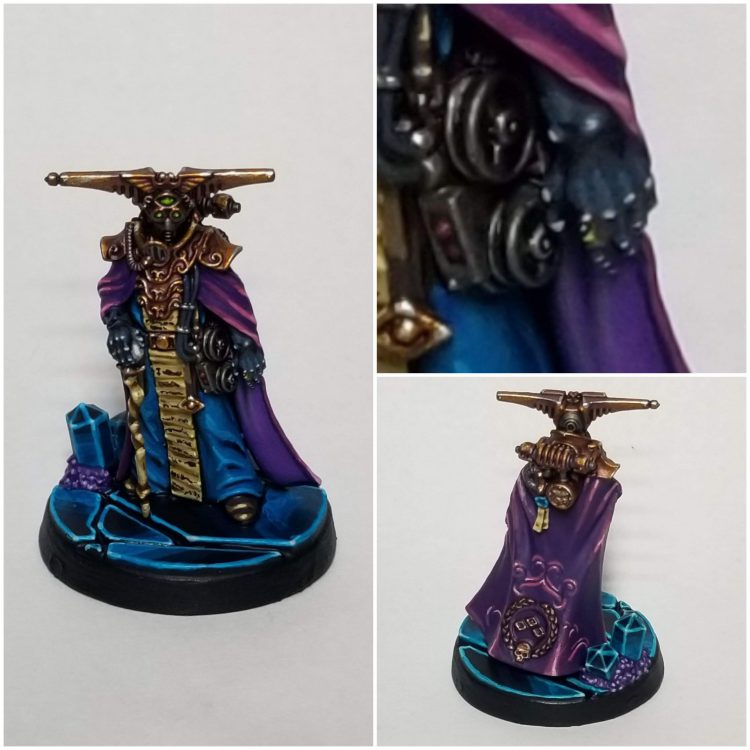
- The Navigator is a Leader that can join either of the two Imperial Navy infantry units, and has some utility tricks. They provide a 12” anti-Deep Strike bubble, and can force a Battle-shock test (with a -2 penalty to INFANTRY) on a nearby enemy unit in your Shooting Phase, dealing three MWs on a failure. As far as the anti-drop bubble goes, Imperium armies could already take that via Inquisitorial Henchmen, so this isn’t totally novel, but the second ability is pretty good, and there are certainly metagames where having this available in the Imperium toolkit will be relevant.
There are also four new datasheets here for Grey Knight Terminators, Sisters of Battle, Immolators and Ministorum priests – each unit is a facsimile of the unit you’d expect to see in that faction’s rules, but transplanted here and adjusted to work in Imperial Agents.
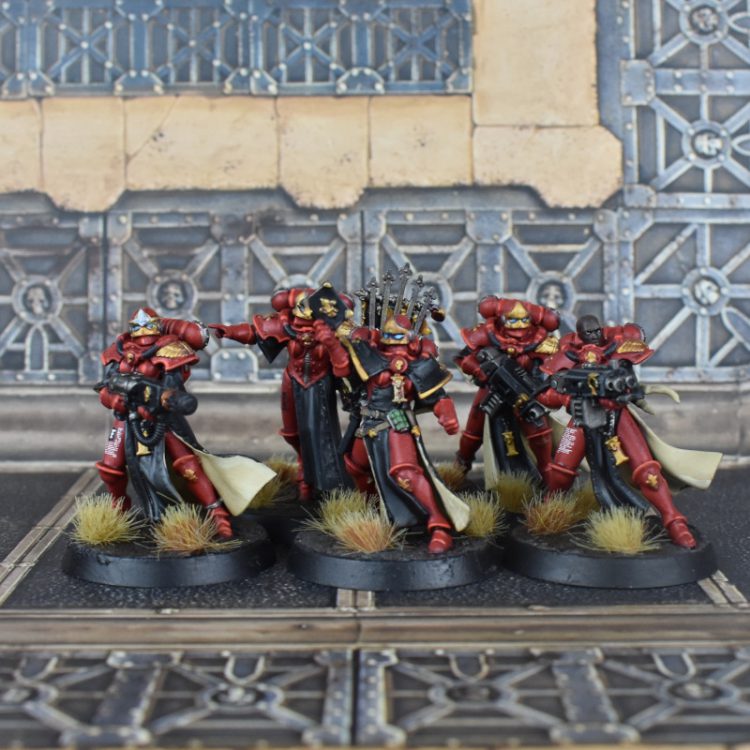
Specifically,
- The Grey Knights Terminator Squad is a recreation of the Brotherhood Terminator Squad from the Grey Knights Index. The big differences here are that the Imperial Agents unit can only have 5 models and if an INQUISITOR unit is attached to them, it gains the DEEP STRIKE ability so that they can drop in with their boys. You do still get access to all the upgrades you’d have as standard, and it’s worth being clear that MSU Grey Knight Terminators are a good unit that shows up in real lists, though obviously without the ability to teleport them around the board freely, they’re a bit less potent. They also don’t gain much from either of the Leaders that can join them, as Coteaz’s invulnerable save is irrelevant, though CP refunds from a regular Inquisitor could be OK.
- The Sisters of Battle Squad is a recreation of the Battle Sisters Squad from Codex: Adepta Sororitas. Like that unit, this one can make objectives “Sticky”, however it has a different cherub rule to represent not having access to Miracle Dice. Instead, once per battle you can hit the unit with a free use of the Command Re-roll Stratagem. Which is a decent approximation of a miracle dice, really. Being able to add a cheap sticky objective unit to Imperial Knights is really good!
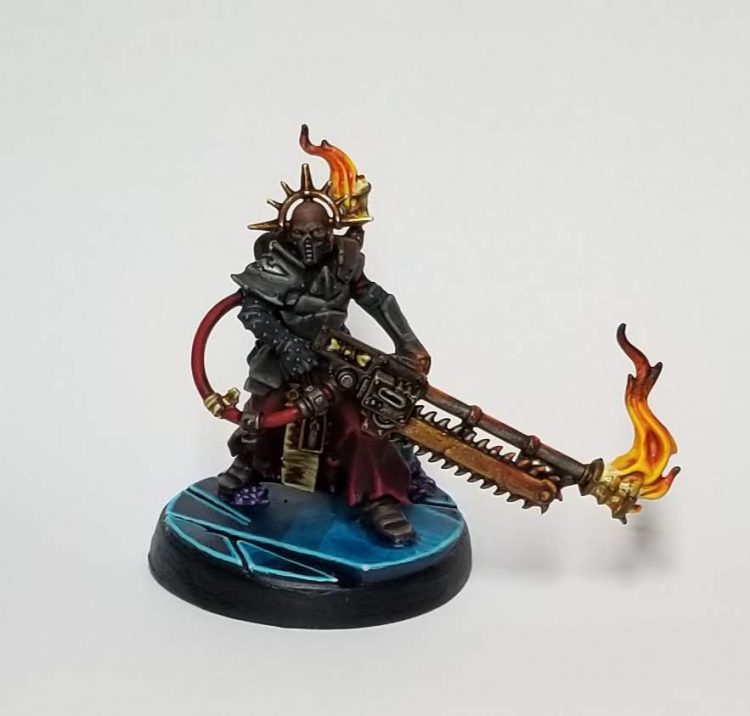
- The Ministorum Priest can lead pretty much any of the non-Marine Infantry units here (except Voidsmen) and provides Sustained Hits 1 in melee. They also get the once-per-battle super mode the Sororitas version has, and there’s a neat Enhancement combo with their eviscerator in the Ordo Hereticus detachment.
The Immolator is just an Immolator, though because the Battle Sisters squad is Requisitioned rather than Retinue (meaning you can only take one), there’s real utility from using an Immolator to split them out into a sticky holder for your home and a mobile positional piece..
Updated Datasheets
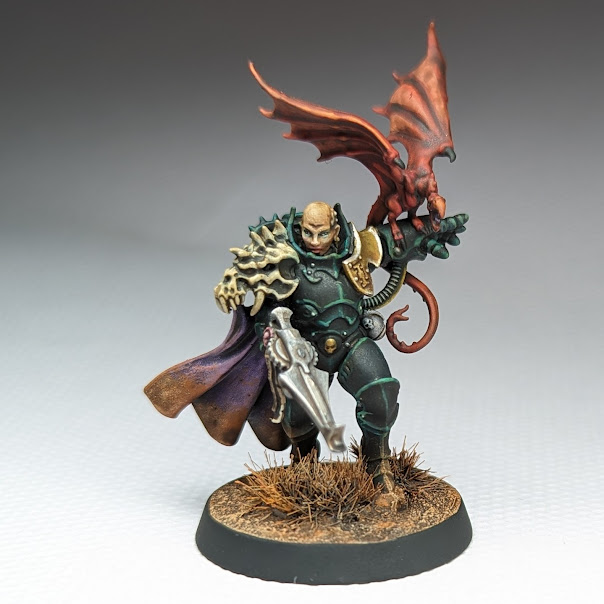
There’s a ton to cover in this section however, and it starts with the Inquisitors themselves.
- Coteaz’s new model comes with a few tweaks to his abilities. He’s still hefting around his big old hammer for some tasty melee swings, but gets a bit less lethal at range, with his Psychic Blast dropping to D1, and only Anti-Infantry 5+ (gaining Anti-Daemon 4+ alongside it). However, he gets a very strong new buff ability at range – in your Command Phase, you can send his bird to sit next to an enemy unit within 18”, and that unit cannot have the Benefit of Cover till your next Command Phase. Ignoring cover is very strong in 10th, and this is an active reason to put him in your lists. Finally, his defensive buff changes slightly – when he’s leading a unit, they have a 6+ Invulnerable Save, increasing to a 4+ against Daemons or Psychic Attacks.
- Kyria Draxus keeps her strong direct shooting and nifty protective buff, but loses Indirect Fire from her Psychic Attack, which reduces her utility slightly. Still seems like a plausible inclusion in Custodes lists (the main place she’s appeared till now), and potentially handy with Deathwatch in an Agents army for shooting squads.
- Greyfax swaps out No Escape (a better version of which is now an Enhancement) for +1 to hit against targets below half strength for her unit. Not ideal, as below half strength effects are just never good.
- Vanilla Inquisitors who forego psychic powers now give their unit a 6+ Invulnerable Save instead of a 5+ Feel No Pain against Mortal Wounds. Depending on where the price ends up, it’s just about plausible you could consider this in a large Death Korps of Krieg unit alongside a Marshall (as they can have two leaders attached) for the Invuln/Feel No Pain double tap, though that probably ends up as too much of a marginal benefit unless it’s very cheap.
Rob: The Inquisitor datasheet is the biggest miss of the codex and it’s not close. These desperately needed a way to gain one of the three ORDO keywords, and not having that is both a mechanical and flavor fail. Or this needed to be three datasheets. Either way, it’s lame.
Wings: To be clear, this doesn’t break that much (other than weirdly letting Epic Hero Inquisitors use rules in the “wrong” detachments because of how they’ve handled keywords, and a few Stratagems) but it’s a very strange choice; this would have been an obvious place for three different units with cool special rules. I suspect the lack of a current plastic generic Inquisitor was what drove this, but that sucks, make one GW.
The Inquisitorial Agents datasheet also replaces Henchmen, and unfortunately is a bit lacklustre. Agents have become better shots, which is helpful (particularly on the gun Servitor, that multi-melta might hit something now), but have dropped to 1W each, and lost most of the weirdo add-ons they could take. They do get a useful new trick from the Tome Skull, which lets them once-per-game either un-battle-shock a friendly unit or force a Battle-shock test on an enemy. They also have a cute bonus to encourage you to take them alongside an Inquisitor, which is that they don’t take up a Retinue slot if an Inquisitor is leading them. How does that work when building an army happens way before attaching units? [REDACTED BY ORDER OF THE ORDO METAGAMIUM].

Next up – Deathwatch. As mentioned, you’ve only got the four units that have unique plastic kits to play with here.
- Happily there’s some good news out the gate for Watch Captain Artemis, who swaps out his (now) useless Stratagem re-use trick for the good clean fun of applying Lethal Hits to a unit he leads. Makes him genuinely plausible as a Leader for a second Kill Team.
- The Watch Master changes out the, uh, “Watch Master” ability (which was working as a CP tax aura post Dataslate) for the standard Marine Captain Rites of Battle ability, providing a Stratagem discount for one Watch Master once per Battle Round. This is very good, both in the Imperialis Fleet Detachment (which has some extremely good synergy with Deathwatch) and when taking a Kill Team as allies for non-Marine Imperium armies, where it essentially gets you a dedicated free CP to work with every turn for what will be one of your spiciest unit. He also keeps Advance/Shoot/Charge for his unit, and although a full Kill Team and a Watch Master is not cheap, being able to tag them into any Imperium list feels like one of the biggest potential impacts from this book.
- Kill Teams are basically rebadged and box-locked versions of the Index Deathwatch Veterans datasheet, with a few extra options to ensure that absolutely every piece of plastic has a place. The upshot is that there’s a bit more of a window to build for either melee or range – if you want melee threats to go with thunder hammers, one model can now take black shield blades, which are basically lightning claws, and up to two can take shields with their power weapons, while if you want to go ranged, you can supplement being able to take a frag cannon and an infernus bolter per five models with a stalker pattern bolt rifle and some D2 shotguns. The end result is still an unusually nasty and flexible Battleline unit.
The Corvus Blackstar remains unchanged. In your hearts, you knew this would be the case and it can sadly spend another edition on your shelf.
The other thing worth flagging alongside Deathwatch is that there’s a datasheet in the book for an Inquisitorial Rhino dedicated Transport for them to ride around in. Because Deathwatch are Retinue units, this means that any Imperium army can now have a Rhino double stacked with scary melee threats, perhaps one Watch Master unit and one squad with Artemis. The double melee staging Rhino has consistently been a defining feature of the 10th Edition metagame, and unleashing it more widely in Imperium seems like it could have some fairly spectacular impacts.
Wings: I would say if anything in this book is going to cause serious balance problems, it’s this. Not every army wants this, but for some factions, Astra Militarum in particular, it plugs a massive hole in their internal capabilities. Could be that it stays priced out of viability, but I think this is real, and will be keeping a close eye on it in Competitive Innovations.
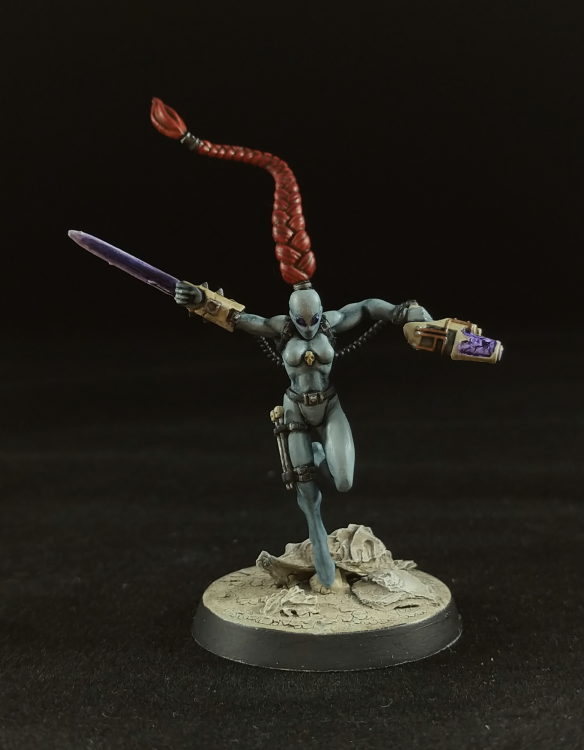
OK, now the exciting one. Assassins! All of these have new tricks, and in a pure Agents of the Imperium army you also get a special bonus – during the Declare Battle Formations step of the pre-game, you can swap out any Assassin in your list for one of the others (as long as you don’t end up with duplicates, or a higher points cost). This rules, particularly because of how they break down – the Eversor and Callidus are great all-rounders, but the Culexus and Vindicares bring something terrifying to the table in the right matchup, so being able to flex to them is excellent. Even saying that, the latter two get enough of a lift that there are probably other Imperium armies that start considering them, the Vindicare especially on Player-placed terrain. This does come at some increased price – the book cost for these is 125pts a pop rather than the current level (except the Vindicare, who is a cool 105). In general the costs here feel slightly high, so there’s a good chance these land in the 110-115pts range, at which there’s some serious attraction (and realistically, they might still be fine at 125pts).
Onto the tricks:
- The Callidus grows more elusive than ever. In addition to being able to go back into Deep Strike at the end of the opponent’s turn (now needing to be >3” from the enemy), if she’s in combat at the end of the Fight Phase she can make a Fall Back move of d6”. Since one of the ways to try and deal with a Callidus was to bully charge her with something she won’t one-round; this now gives an out for that on a 4+. It also helps her bob and weave when fighting in ruins, giving some extra flexibility to flummox the foe.
- The Vindicare is ready to strike fear into the hearts of elves everywhere, because he flat out ignores the Lone Operative ability. He also gets +1S on both his guns (which is a meaningful break point in both cases), and an upgrade to his Shieldbreaker Round ability. Rather than ignoring Invulnerable saves, this now gives the attack +1 to Wound and makes any Wound Critical (i.e. Devastating), so if you’re sniping a Character you’re overwhelmingly going to be looking for 2s and 2s to deal d3+3 Mortal Wounds. You will, naturally, roll a 1. It also makes this ability more flexible to taking a big chunk out of a priority target like a tank.
- The Culexus gets one new trick and one improved one. The new trick is that they can do a 3” Deep Strike at the cost of not being able to Charge, which is a powerful utility trick in general, and more likely to be relevant in combination with Rapid Ingress here than it would be for, say, Inceptors, because with Lone Operative you’re much better able to control how many things can shoot you if you do. It also combines with the other change – they lose the flat aura of penalty to leadership, but their once-per-game battleshock blast now has a range of 9”, and applies a -1 penalty on the test. This sets up the pretty obvious combo of 3” dropping the Culexus in between two objectives, then doing their best Tyranid impression with wide-ranging Battle-shock tests.
- Last but not least, the Eversor. Good grief. You know how in the Index you had to pick between Precision, Advance/Charge or Sustained Hits 3? Yeah, that was boring, those are just all on all the time now, and you also get a once-per-game Solitaire-style super mode when you NOrmal Move, giving you +6” Movement and +3A. Combined with Scouts 9”, that means that from a standing start on turn 1 an Eversor can stroll a leisurely 24” across the battlefield then Charge, and then swing with 9 D2 attacks with Sustained Hits 3, Precision and Anti-Infantry 3+. Neat. As you may have guessed, this is the one that could probably comfortably stay at 125pts.Might be safer that way.
Rob: Assassins are also a problem – the Eversor’s speed is just insane, able to go 24” before charging, and the Vindicare can be a nightmare for armies relying on character effects, especially given most characters have fewer than 6 wounds. Yeah those times your opponent rolls 1s to hit/wound even after a re-roll will be hilarious, but those aren’t going to happen often enough to make up for the pain of just auto-losing a character each time the Vindicare fires up the old penetrator round.

Onward to our next weirdo category – the Arbites. All three of these units share a change, which is that the Nuncio-Aquila is massively improved. Instead of a near-meaningless 3” aura of -1Ld, each Aquila now gives you a once-per-game ability used at the start of either Command Phase, picks an Objective Marker within 6”, and forces all non-VEHICLE/MONSTER enemies in range of it to take Battle-shock tests (you can only target each objective once per turn). If there’s a tournament-winning list in this book it’s going to lean heavily on Primary denial, and this is a surprisingly vicious tool to give to random Infantry units.
Beyond that there are no changes to Vigilant and Subductor Squads, though the latter are very much still going to be a key part of building an army from this book, as they’re relatively cheap invuln-toting Infantry. Exaction squads get a few more changes. They’re now fixed at 10 models, but their Imperial Law ability improves considerably – rather than providing +1 to hit against a chosen target, it now provides Lethal Hits and Precision. This helps their (fairly weak) weapons punch up into a big target if you find yourself against (e.g.) Knights, and like many such abilities has a nice knock-on of enhancing the weapons of an attached Inquisitor. This feels most relevant with Kyria Draxus, whose Psychic Veil is also good here. Finally, their medic swaps from providing a 5+ Feel No Pain to reviving d3 models in your Command Phase, which is helpful if you’re trying to overwhelm your foe with bodies.
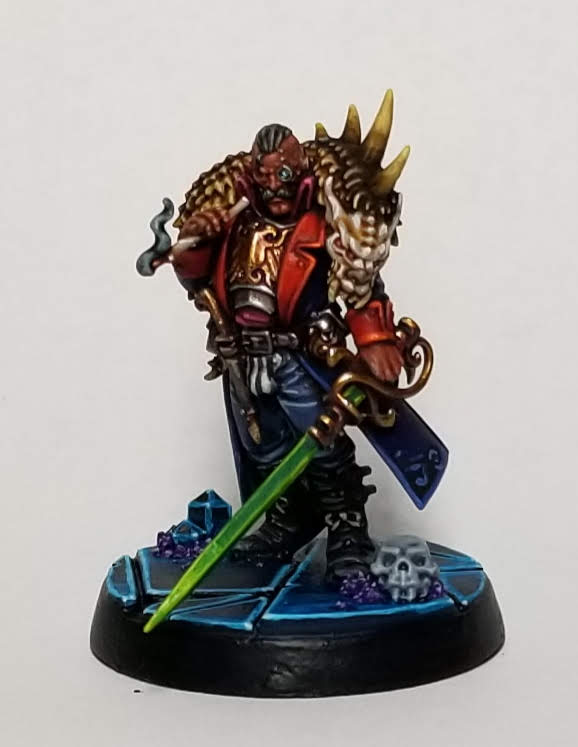
Our final category of Imperial nonsense are the Voidfarers, ready to sail the seven Segmenta. I do not know if there are seven, and I will not be checking.
The centrepiece here is obviously the Rogue Trader Entourage, a rogue trader and three supporting specialists who can join either of the other Infantry units. They have some okay output at range and up close, and you can also pick one Rogue Trader to gain Infiltrators in Declare Battle Formations, plus redeploy some battleline units. The only change to the unit (other than only one being able to infiltrate now) is that their medic also changes from a 5+ Feel No Pain to reviving d3 models (excluding Characters). This feels pretty good, all things considered – while Characters can’t be revived, the Lectro-Master and Death Cult Assassin can, giving you two 2W 4+ Invulnerable save models that provide a fair bit of ablative durability. If your opponent is focus-firing you with D2 weaponry it’s worse than a 5+, but in most other cases it’s going to be better.
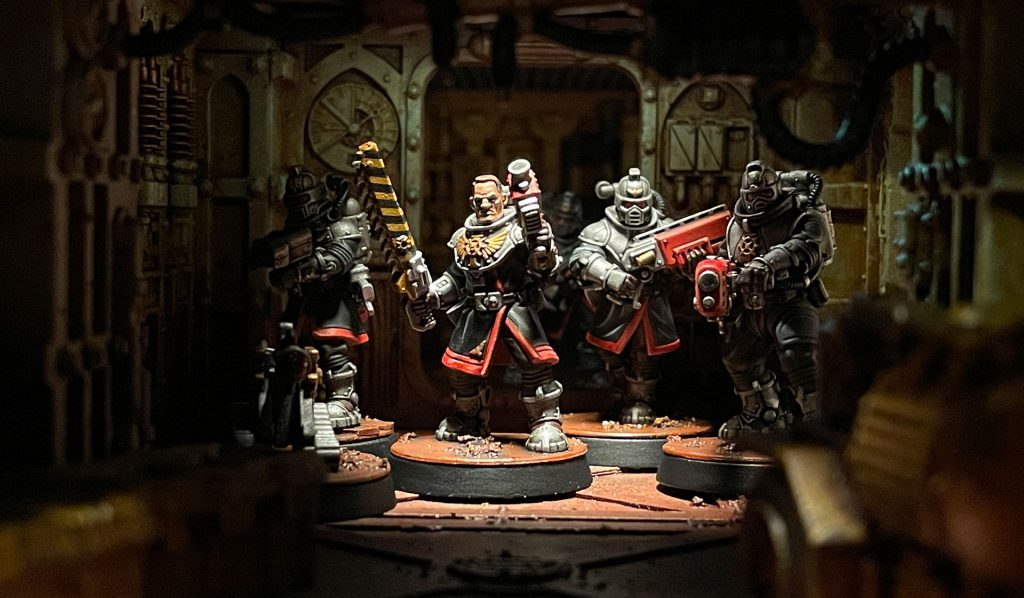
The premium unit to put these with are Navy Breachers, who have a reasonably good all-round set of kit, plus one more helpful 4+ Invulnerable model with a shield. They also get wound re-rolls against targets on an Objective, which works well with the entourage and has good synergy with the Imperialis Fleet detachment rule. They also get abilities for their two wargear models, with the CAT Unit giving once-per-game Ignores Cover (good combo with Close-Quarters Barrage in the detachment), and the Gheistskull replacing their Grenade Belt with the extremely good ability to throw a Grenade at 18” once per game. Finally, their Leadership is no longer inexplicably terrible, going to a nice average 7+.
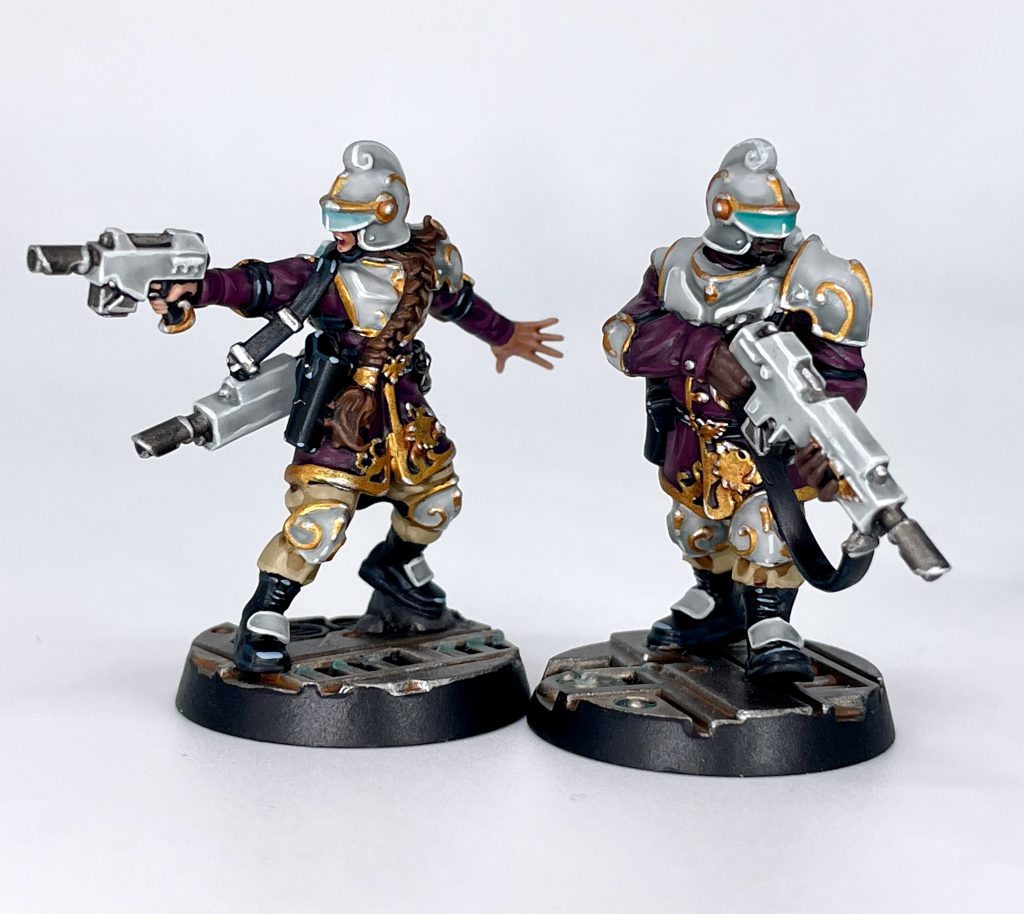
That’s also true for the Voidsmen at Arms, who otherwise don’t really change except for being fixed at the small squad size that includes a mandatory Canid. Given that their printed cost is the same as the current MFM cost, that’s (probably) one model of free real estate if you’re taking these as cheap add-on Infantry in an Imperium army.
How They Will Play
Rob: This is a book full of narrative rules, bad detachments, and mostly decent datasheets that will have an insane, warping effect on the meta. Our only hope is that the “two sets of points values” delivers an army that is relatively balanced when using its own detachments but not undercosted when it comes to inclusion in other Imperium armies. That said, I’m not wild about what a cheap version of this army’s points might look like – it’s very possible they turn this into a horde army of Deathwatch Veterans and Sisters and I’m not sure that’s any better.
Wings: Realistically, if anything gets there it’s the Imperialis Fleet with a bunch of scoring and movement jank, plus some Deathwatch Veterans as hammers. Whether it lands will depend on a mix of the metagame and how hard they go on making things cheaper in pure Agents armies.
Final Thoughts
Wings: This is a tricky one, because I like what’s been tried here, but the implementation just doesn’t get there. Conceptually, the fact that 10th’s systems let you create this kind of patchwork army is really cool and there’s a lot of promise in it, but the implementation here makes some major mistakes that undermine the impact.
The key one is making the detachments way too restrictive in what works in each. There’s a reason that the Imperialis Fleet is light years ahead of the rest – because you can play with all of the units. This book is already drawing on thin slices of a bunch of other factions to assemble a coherent whole, and if you cut it down further than that there simply isn’t enough to work with. Deathwatch get a particularly raw deal on that front, and I’m honestly not sure what the thinking behind their detachment was – if it doesn’t work with anything else in this book, why is it even here? The others are a bit more understandable because they are at least working to an agents theme, but they still end up way too narrow.
Wider than that, it’s very odd that the assembly of datasheets here has such a glaring gap in anti-Monster/Tank capability. At the point you’re importing a bunch of units from elsewhere, you’ve got a perfect window to ensure you at least partially cover all the bases, but that just hasn’t happened here and it’s a missed opportunity to make something cool.
I guess the advantage for this book on these fronts is that it’s much easier to make some fixes after the fact. We were chatting through what this book needs added, and honestly you could fix a tonne of its sins just by adding “Inquisitorial Tempestus Scions” and a rule that they gain the relevant Ordo keyword in the specialised detachments. This feels perfectly lore compliant and gives the faction something with some actual punch to work with, especially if you add Taurox Primes as well.
That doesn’t solve the issues with Deathwatch, and honestly for them just add a rule that if you take them as Agents in an Adeptus Astartes army, they gain the Adeptus Astartes keyword. That way people with existing collections can still have fun with them – they all own Codex Space Marines anyway! I genuinely cannot fathom how what’s here was considered “good enough” for Deathwatch, it’s such a mess.
If you’re running this army pure in anything like a competitive setting, at least have the Imperialis Fleet, and that does look like fun! I hope the few players dedicated to the faction get a lot of use out of it – it’s a well designed detachment and a high point amidst the negativity.
As regards using Agents as allies, I’m kind of ambivalent. I do like that Assassins get a proper scary glow up, and as long as the points stay sensible that’s a better place for them to be than as pure cheap objective filler. As a lifelong Xenos player I slightly resent the extremely broad range of add-ons that Imperium get here otherwise (that’s honestly probably why Tempestus Scions are not here), but unless the Deathwatch party bus ends up at a broken level of points, I don’t think it’s that different from where we are now, and I do like the angle of letting newer players ally in units to get their force towards 2000pts.
Overall – big bold experiment, big missed opportunity, hope they can fix it in post.
TheChirurgeon: I’m not a fan of this book. While it’s hard to evaluate things without the dual points values for units that we were promised, I’m very worried that the costs for assassins and at least one ally unit will come in low enough to completely bust things, helping Sisters and Astra Militarum jump to the top of their current tier – and they’re already among the game’s best armies.
The bigger issue is that the rules and detachments for running Agents armies are just bad – they feel like an afterthought. If you’re a more narrative or casual gamer, these rules don’t offer enough of the flavor and crunch to make the kinds of cool armies and warbands they want to make. You don’t have enough units to do a full army of Deathwatch, Ordo Malleus, or Ordo Hereticus, leading to adding in a bunch of rogue traders, arbites, and navy breachers. The biggest miss here is not including Tempestus Scions, who are both known for being part of Inquisitorial warbands and who struggle to find a meaningful place in Astra Militarum armies anyways. The army really needed its own version of the Brood Brothers rule, letting it take Tempestus Scions and Kasrkin but omitting the likes of Artillery and tanks. That would give you much more flavorful options to fill out an Ordo Malleus army with. As it is, you’re just going to run Grey Knights and add Coteaz as an ally.
The other big miss is not having any kind of Inquisitor customization. They’ve managed to dodge most of the keyword misses there by giving Stratagems play on INQUISITORIAL AGENTS but the Inquisitor datasheet really needed the ability to assign them to an Ordo, or needed to be three different datasheets with different abilities for each. As it is, only the three named Inquisitors in the book actually belong to an Ordo, and their Leader abilities let them ignore that distinction anyways to lead Deathwatch Kill Teams.
At the end of the day, this book is likely to cause problems competitively by giving the Imperium factions too many options to cover what should be legitimate gaps in the faction. Wings and I are on the same page here – as a Chaos player it’s insane to see the hoops Chaos players have to jump through in order to get Daemons or lose rules for cult troops when Imperium players can just add whatever they want from this book. And if you’re not playing competitively well, it’s not great either… with one exception.
And that exception is Boarding Actions. This book drops at the same time as boarding actions and while I think that these rules are pretty lame for 40k proper, the new edition of Boarding Actions looks great, and these rules are just fine for taking 500-point forces. So if you’re going to play Boarding Actions, this book is a much better pick-up, and the BA detachments for Imperial Agents are solid.
So who is this for? Well, my answer to that is Boarding Actions players, competitive players looking to run assassins and fill other gaps, and people who really want a modern book with that sick Coteaz cover.
Have any questions or feedback? Drop us a note in the comments below or email us at contact@goonhammer.com. Want articles like this linked in your inbox every Monday morning? Sign up for our newsletter. And don’t forget that you can support us on Patreon for backer rewards like early video content, Administratum access, an ad-free experience on our website and more.
